 Last year, I reviewed Simaudio’s Moon Evolution 760A stereo amplifier, a product that earned a Reviewers’ Choice award and left me nothing short of enamored. The adoration I developed for the 760A while listening to it for that review was not the result of enchantment with prior expectations or its appearance. Quite the opposite -- when it was delivered, I recall being concerned that Simaudio had missed the mark in setting the 760A’s price: its stature and power specifications seemed a bit modest for $8000 USD. Then I listened to it, and, as related in my review, my uncertainties swiftly dissolved.
Last year, I reviewed Simaudio’s Moon Evolution 760A stereo amplifier, a product that earned a Reviewers’ Choice award and left me nothing short of enamored. The adoration I developed for the 760A while listening to it for that review was not the result of enchantment with prior expectations or its appearance. Quite the opposite -- when it was delivered, I recall being concerned that Simaudio had missed the mark in setting the 760A’s price: its stature and power specifications seemed a bit modest for $8000 USD. Then I listened to it, and, as related in my review, my uncertainties swiftly dissolved.
Just before Christmas, I was asked if I’d like to review Simaudio’s all-new flagship DAC, the Moon Evolution 780D, and here I am, again wondering -- this time with less skepticism and decidedly more excitement -- if this Simaudio product can really be worth its lofty price, in this case $15,000.
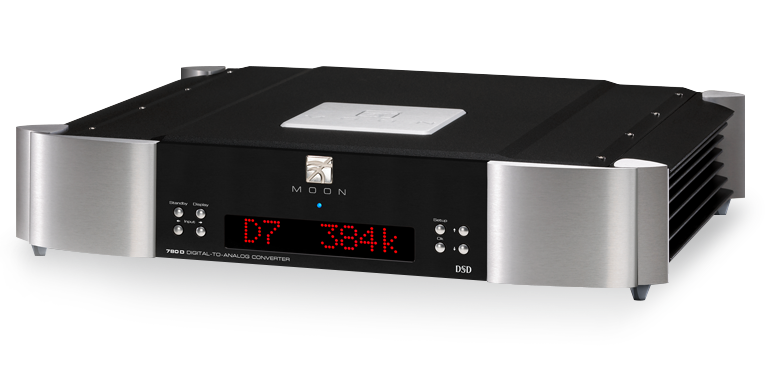
Architecture
Not long after I took delivery of the Moon Evolution 780D, Lionel Goodfield, Simaudio’s manager of public relations, sent me an e-mail to which he’d attached a white paper outlining the technologies the company had poured into this DAC. He also stressed that the 780D demands at least 300 hours of break-in: I should have a quick listen to it fresh out of the box, then forget about it until it had fully cured. Feeling like a four-year-old set down in front of a giant chocolate bunny and told not to eat it, I used this time to read the white paper. I learned that the 780D is a technical tour de force.
Out of the box, the 780D drips quality. It measures 18.75”W x 4.0”H x 16.8”D and weighs 35 pounds, the latter due in large part to the copius amounts of aircraft-grade aluminum used throughout its chassis and case, all but a few pieces of which are milled on Simaudio’s in-house, five-axis CNC machine. Assembled, the 780D’s fit and finish are exemplary, and gave me a feeling of luxury every time I looked at or touched it. The DAC is available in three finishes: all silver, all black, or black with silver “cheeks,” as Simaudio calls them. My all-black review sample looked bad-ass.
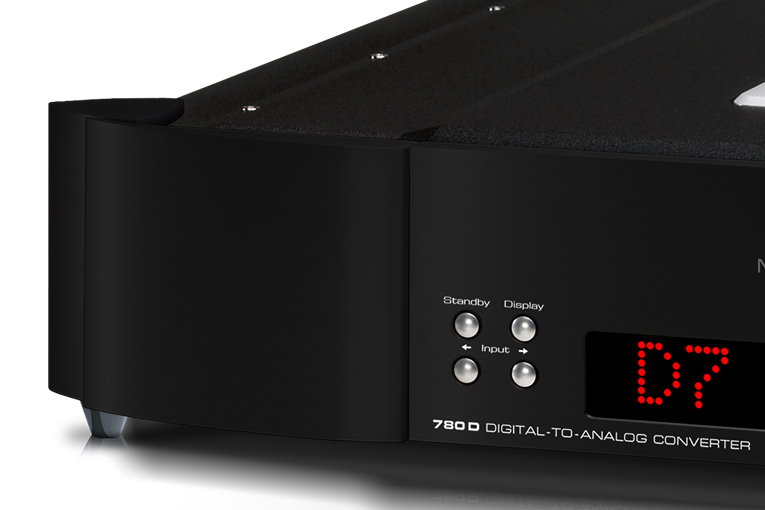
On the clean, uncluttered faceplate are two quartets of small buttons, between them a large, easy-to-read red-dot matrix display. The four buttons on the left are labeled Standby, Display, and Input (previous and next); the four buttons on the right, devoted to managing the setup functions, are labeled with Setup, OK, and up and down arrows. Unlike the Moon Evolution 750D ($14,000; discontinued), the 780D has no optical drive; it does include Simaudio’s MiND streamer, which not only grants you access to Tidal’s immense music library, but also allows, via Ethernet, native streaming of PCM resolutions up to 24-bit/192kHz, and DSD up to DSD64.
The top plate, also hewn from solid aluminum, is chamfered at each edge, which adds dimensionality to its appearance while simultaneously drawing the eye to an embedded plaque engraved with the Simaudio logo and, below it, “Moon.” As on all other Moon Evolution models, horizontal heatsink fins of solid aircraft-grade aluminum comprise the 780D’s side panels and lead the eye around to the rear.
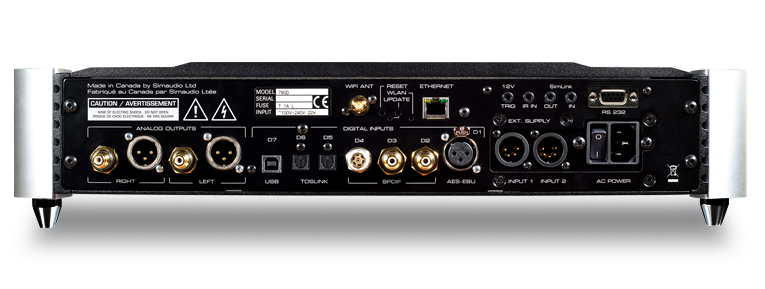
At the center of the rear panel are eight digital inputs: USB (capable of reading all resolutions up to 32-bit/384kHz PCM and DSD256), AES/EBU, S/PDIF (x3), optical (x2), and Ethernet. Wireless connectivity is supported through Wi-Fi and Bluetooth aptX. There are also MiND update and reset buttons, and a connection for a Wi-Fi antenna. At far left are one pair each of balanced and unbalanced analog outputs, and at far right an IEC power receptacle, a power toggle, access to a 12V trigger output, SimLink input and output jacks, a bidirectional RS-232 communication port, and a pair of terminals offering connectivity to Simaudio’s optional 820S external power supply ($8000).
Inside the 780D are four layers of circuitry, all made with tracings of pure copper. The left- and right-channel audio signals occupy the first and third layers, the ground plane the second layer, and the power supply the bottom layer. These circuits contain pretty much every proprietary technology in Simaudio’s arsenal, including a heavily shielded power supply, and advanced digital-signal and jitter-control processing. At its core, the 780D is a fully balanced design with one 32-bit ESS Technology Sabre ES9018 DAC chip per channel running in mono mode, for true dual-mono operation. Each ESS DAC chip contains 16 individual DAC circuits, to provide eight differential-mode DAC circuits. For each channel, outputs from eight DACs are summed to create the positive signal, and outputs from the remaining eight DACs are summed to create the negative signal. Because a DAC’s output is measured in current, the output of the eight DACs can easily be summed to yield a better result than when using only one DAC per channel. Simaudio says that they chose this design because each DAC has unique imperfections that become diluted within the current of all the other DACs. Simaudio also claims that the minuscule imperfections in each of the DACs in a circuit are fully canceled out as a result of the differential topology. The result of this design, which Simaudio calls their M-AJiC32 (for Moon Asynchronous Jitter Control in 32-bit) circuit, is said to produce lower levels of noise and distortion that translate into better measurements and higher sound quality.
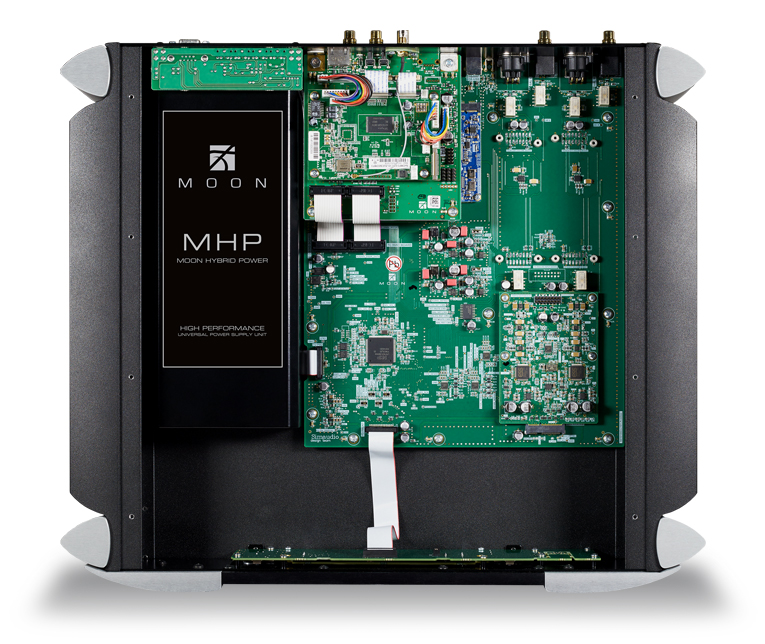
One drawback to using such an accurate DAC topology is that connecting to external digital devices via S/PDIF, AES/EBU, optical, or Bluetooth aptX can sometimes be problematic, due to significant jitter. To combat this in the 780D, Simaudio uses their proprietary Dual Jitter Control System in conjunction with M-AJiC32. In a nutshell, these technologies work together as parts of two stages of ultra-high-quality jitter reduction: the former in a standalone sample-rate converter, the latter in the actual DAC circuit. Together, they give the 780D the ability to accept a wide range of digital input signals with very high jitter (>1000 picoseconds) and output a digital signal virtually free of jitter (<150 femtoseconds). (A picosecond is one-trillionth of a second; a femtosecond is one-quadrillionth of a second.)
While the Sabre ES9018 is known for its stellar performance, simply dropping a pair of these exalted DAC chips into a snazzy case designed to damp resonances won’t, by itself, yield groundbreaking sound. The key, as Simaudio is keenly aware, is to ensure that the implementation of these chips and their supporting circuits are of the highest quality. One of the most important variables to optimize in any audio component is the power supply, and the 780D incorporates three of Simaudio’s proprietary technologies, starting with Moon Hybrid Power (MHP): a standalone modular power supply, housed in its own enclosure inside the 780D, that cleverly combines switch-mode power and linear regulation to provide minimal levels of AC voltage fluctuation, harmonics, and noise.
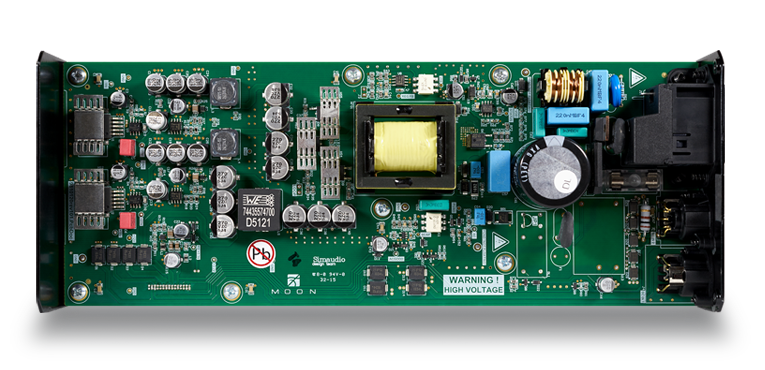
The 780D is also equipped with Simaudio’s M-LoVo technology, which those of us who aren’t electrical engineers can think of as a very-high-quality, discrete voltage-regulation circuit. M-LoVo is located on the audio PCB prior to any processing of the audio signal, and comprises a clever combination of integrated circuits and discrete parts that results in a seemingly impossibly low noise floor of -150dB at 1.0V from DC to 100kHz. M-LoVo, designed specifically for the audio signals typical of streaming DACs, is said to provide exceptionally fast, precise, stable DC voltage.
Simaudio has also equipped the 780D with their Independent Inductive DC Filtering (I2DCf technology. Found in all Moon Evolution products, I2DCf is a unique type of DC voltage regulation implemented in stages, each stage helping to eliminate glitches resulting from DC power feeding the components in the 780D’s audio signal path while helping to isolate those components from each other. The benefits of this are said to be better noise filtering (in this case, a signal/noise ratio of 124dB at full output), substantially lower total harmonic distortion (0.0001%), improved channel separation (120dB), lower crosstalk, reduced jitter, and steadier DC voltage throughout the entire circuit. Unlike Moon Evolution models that use many stages of I2DCf, the 780D has only four, due to the inclusion of MHP and M-LoVo.
Performance
With the Moon Evolution 780D installed and fully broken in, I took advantage of Simaudio’s proprietary SimLink technology, which lets you link any number of SimLink-equipped Simaudio components to function as one: Put one Simaudio component in standby, and all SimLinked components stand by. Likewise for display settings or even power up: turn on the 780D, and the linked preamp automatically switches to the appropriate input.
With numerous digital inputs to evaluate, plus Tidal, I began with a Tidal stream of “Child of Vision,” from Supertramp’s Breakfast in America (16/44.1 FLAC, A&M). Within seconds, the 780D was exhibiting three different qualities that I continued to hear with every recording I threw at it. First and most obviously, the 780D seemed to thrive on presenting aural images of appropriate size with a complete lack of congestion. Rick Davies’s piano and John Helliwell’s saxophone burst into my room with palpability and dimension. Additionally, the 780D let music flow through it with what I can describe only as unfailing levels of transparency. Subtle nuances, such as the reverb of Bob Siebenberg’s drums, particularly on every fourth beat, and the luscious decay of Davies’s piano notes, were now so easily heard that I wondered how I’d ever missed them before. Allowing both of these attributes to be fully appreciated was the 780D’s final and perhaps most important talent: precision. Be it instruments, voices, micro- or macrodynamics, or newfound nuances, each was presented with pinpoint specificity, dimension, scale, and weight.
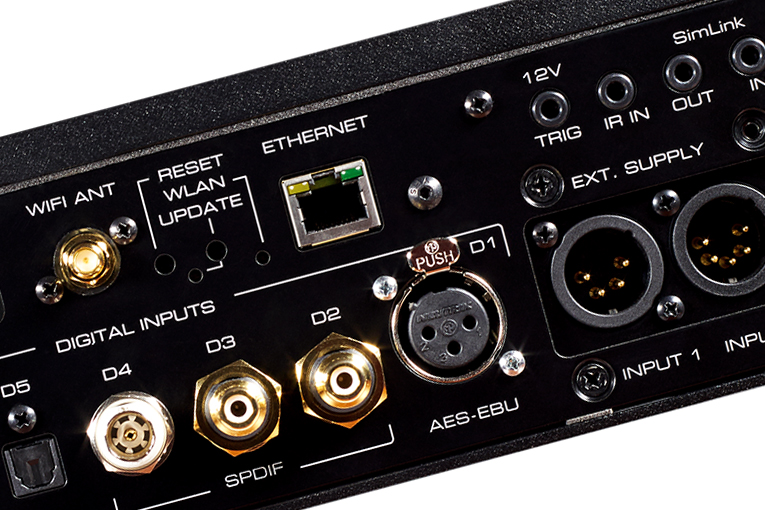
Having heard all this with a standard 16/44.1 file streamed from Tidal, I decided to evaluate what, if any, differences I could hear through the 780D’s other digital inputs. Using my Oppo BDP-103D universal BD player as a transport, I sent a bitstream of “Child of Vision” from my connected NAS device to the 780D using both Analysis Plus’s Digital Crystal coax and optical cables, and heard little to differentiate them from Tidal. Lacking a source with an AES/EBU output, I was unable to test this input.
I moved on to the 780D’s streaming options: Bluetooth aptX and the onboard MiND streamer. I focused first on the former, using my iPhone as a source. In my experience, the 780D broke new ground in terms of the overall quality of sound I can expect from music streamed via Bluetooth. While somewhat less focused when compared directly with Tidal, and a bit more reserved in the bottom end, other attributes -- soundstage dimension, tonal color, dynamic impact, and object density -- far exceeded those of any other Bluetooth DAC I’ve heard. Equally remarkable were the audible improvements I heard when I switched from Tidal to the 780D’s onboard MiND streamer. As both are internal ways to losslessly stream music routed through the same DAC, I expected the sound to be pretty much identical -- yet track after track, music streamed through MiND sounded a wisp warmer, fuller, and overall more refined. I also noted subtly yet consistently more weight and definition to bass notes, particularly when listening to the double bass in Musica Nuda’s Come Together (16/44.1 FLAC, Bonsai Music).
I reviewed the MiND streamer in October 2014, so I won’t go into its functionality here; except for some integration upgrades and a refresh of its app, it has remained unchanged since then. What has changed is the number of formats the MiND can decode. Once limited to 24/192 PCM, MiND streamers built into Moon DACs now natively accept and decode DSD64 (2.82MHz). Furthermore, in addition to PCM resolutions of up to 32/384, the 780D can also natively decode and process DSD128 (5.65MHz) and DSD256 (11.29MHz), using Simaudio’s latest asynchronous USB input. Having established that the MiND yields the best sound quality overall, I proceeded to use it for the rest of my listening.

The 780D really strutted its stuff with Joss Stone and Jeff Beck’s cover of Screamin’ Jay Hawkins’s “I Put a Spell on You,” from Beck’s Emotion & Commotion (16/44.1 FLAC, Atco). It faithfully communicated the dynamic drive of Vinnie Colaiuta’s punchy drums, Chris Bruce’s tuneful bass, Stone’s seductive singing, and, of course, Beck’s invigorating electric guitar. The 780D excelled at balancing the dynamism of the drums, voice, bass, and guitar against subtler details that, until now, I hadn’t fully appreciated. For example, I could hear not only the snappy decays of Colaiuta’s drums, but also the subtleties of his brushstrokes on the skins. This isn’t all that hard to follow toward the beginning of this track, but such subtleties had previously been mostly lost in the congestion of Beck, Bruce, Stone, and Colaiuta going full steam ahead. Also appreciably more present was the physical impact of the drums, perfectly timed against the bass, especially in a crescendo in which Colaiuta seamlessly transitions from brushes to brass, and Bruce matches his beat note for note. With each impact, I could not only hear but feel in my chest the seamless impact of drums and bass -- and there’s nothing like feeling the music in your body to help convince you that you’re actually there. Nor could I help but relish the focus and palpability of Stone’s alluring voice, locked in place at center stage. Man, this woman can sing -- the 780D did nothing to inhibit the seductive smoke in her voice, or the incredible tonal range and intoxicating levels of power she can conjure up on a breath’s notice.
I’d be remiss if I didn’t touch on Beck’s electric guitar, but I think what stood out most about how the 780D reproduced its sound was how the guitar didn’t stand out from the mix until called on to do just that. Most obviously identifiable by the leading edges of his pick slides for the better part of this track, Beck’s electric guitar pops up on center stage only about halfway through, played as Stone sings. The 780D convincingly placed Beck’s axe slightly behind Stone but in front of Colaiuta’s drums -- exactly where he’s supposed to be. The guitar sounded smooth and vibrant. Even more endearing was how refreshingly free of dynamic compression it sounded, with a sense of ease and focus that not only filled my room, but had me wanting to pump up the volume every time I hit the back button.
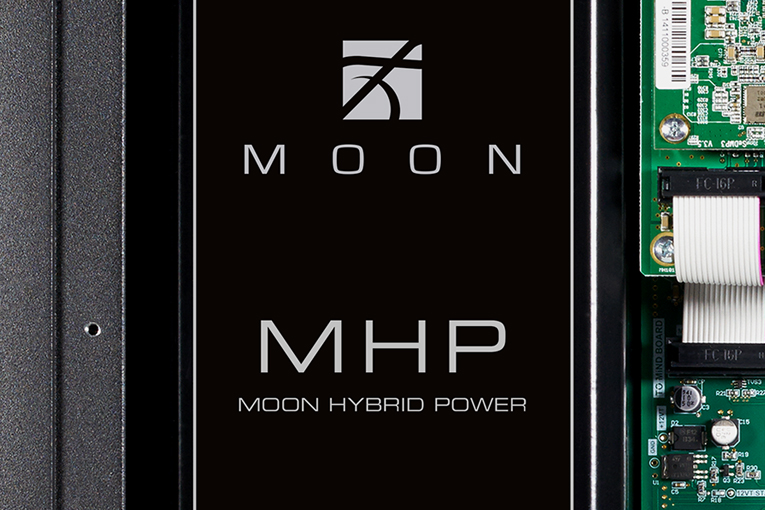
Having repeatedly listened to this track, I was ready to move on to something a bit more subdued. I cued up Irving Berlin’s “Let’s Face the Music and Dance,” from one of my few DSD albums, Diana Krall’s When I Look Into Your Eyes (DSD64, Verve). It took virtually no time at all to hear the advantages of listening to a DSD64 file instead of a 16/44.1 FLAC file. Drummer Jeff Hamilton and guitarist Russel Malone open the track. Through the 780D, I could better appreciate the delicacy with which Hamilton tapped the brass, while Malone’s electric guitar sounded smooth, rich, yet skillfully articulated. Soundstaging was vastly improved, and Krall’s voice sounded considerably more smooth, focused, and textured, and John Clayton’s double bass had more weight and more precisely defined pitches. But it was the masterful control of Clayton’s bass, anchoring center stage, that made me fully appreciate how well the 780D took advantage of DSD. I’ve heard this track countless times, and more often than not, Clayton’s instrument sounds a bit bloated or loose as it blooms. This simply did not happen through the 780D -- Clayton’s bass had weight, but as it bloomed I never lost “sight” of the strings, or of his fingers as he plucked them. When Krall’s piano entered, notes seemed to float well in front and outside of my Rockport Technologies Atria speakers, and with a tonal purity that I found addictive. As I listened to each note filling the room, I learned to anticipate the quick transient attack of the next key being depressed even as the decay of the previous note wonderfully lingered. Much of what I’d heard in the reproduction of Joss Stone’s voice was repeated here. Subtle or blatant, Krall’s vocals were communicated with tremendous textural detail, precise image specificity, effortless dynamism, and just the right amount of warmth. The quality of sound put forward by the 780D with DSD files was, in a word, beautiful.
Comparison
At $15,000, and replete with nine digital inputs including a streamer, the Moon Evolution 780D is hard to compare. The most comparable component I had on hand was my current reference DAC, a Calyx Audio Femto ($6750). On paper, the Calyx and Simaudio measure similarly, despite the Calyx’s lack of DSD or PCM processing above 24/192.
These were two very different-sounding DACs. The 780D cast a more expansive soundstage with Stone and Beck’s cover of “I Put a Spell on You,” and exhibited purer timbres throughout the midrange. I also heard more air around instruments, struggled less to hear microdetails, and experienced no fatigue at higher volume levels, due to a level of refinement the Calyx couldn’t match.
Swapping out the 780D for the Femto produced an immediate reduction in volume, and Stone’s voice sounded cooler, almost shouty by comparison. Despite leaning slightly toward the cool side of neutral, the delicacy and microdetail I’d enjoyed in Vinnie Colaiuta’s brushwork through the 780D were now less easy to hear, and the decay of his sticks hitting the drums was also slightly diminished. On the other hand, Chris Bruce’s bass was, surprisingly, presented with greater overall slam, impact, and macrodynamics.
The Calyx Femto is a heck of a good DAC with a sound quality that punches way above its price. The Simaudio Moon Evolution 780D outclassed it.
Conclusion
To say that I like Simaudio’s Moon Evolution 780D would be a gross understatement. I’m enchanted by it. It’s the best-sounding DAC I’ve heard in my system, and quite possibly the best-sounding DAC I have heard, period. With its luxurious-looking case of aircraft-grade aluminum, exemplary build quality, unparalleled connectivity, and onboard MiND streamer, the 780D is a distinctive product worthy of its flagship title. Add to all that an array of proven technologies hell-bent on chiseling highly focused, refined, dimensional images positioned on vast soundstages, and you have the recipe for a product poised to extract the last iota of performance from any system. Simaudio’s flagship streaming DSD DAC has left me gobsmacked, and convinced that it’s worth every penny of $15,000. In doing so, it has also earned my highest praise: a Reviewers’ Choice award. Well done, Simaudio!
. . . Aron Garrecht
arong@soundstagenetwork.com
Associated Equipment
- Speakers -- Rockport Technologies Atria
- Subwoofers -- JL Audio Fathom f112 (2)
- Amplifiers -- Rotel RMB-1585, Simaudio Moon Evolution W-7M (2)
- Preamplifiers -- Marantz AV8801, Simaudio Moon Evolution P-8
- Sources -- Oppo Digital BDP-103 universal BD player, Simaudio MiND music server
- Digital-to-analog converter -- Calyx Audio Femto
- Cables -- Analysis Plus Digital Crystal S/PDIF and AES/EBU and Silver Oval-In interconnects, AudioQuest Coffee AES/EBU link, Kimber Kable Select KS-6063 speaker cables, Cardas Clear Blue Beyond power cables
- Power conditioner -- Torus Power AVR2 20A
Moon by Simaudio Evolution 780D Digital-to-Analog Converter
Price: $15,000 USD.
Warranty: One year parts and labor (ten years with product registration).
Simaudio Ltd.
1345 Newton Road
Boucherville, Quebec J4B 5H2
Canada
Phone: (877) 980-2400
Website: www.simaudio.com






















